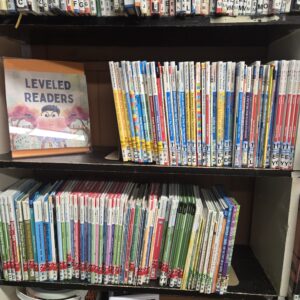Learning to read is a complex skill and supporting your child as they learn to read can be difficult. Once children start public school, you may hear a lot about their “reading level.” It’s important to understand that a reading level is a suggestion not a rule. It is only an estimate that a child will read at a particular level in a particular grade. Each school district might use a different system for measuring reading level, as there are many different models available. Many publishers of children’s books available in the library are also given a level that roughly matches levels a school might use. Popular examples of publishers creating leveled books are Ready-to-Read, ICanRead, and Penguin Young Readers. At the library, these books are in their own section for easy location.
We know that children grow and learn at their own pace. This guide is simply to help support reading at home. If you know your child’s reading level at school, choosing a leveled reader from the library collection can be easier with this chart.
Ready to Read
| Level | Description | Grade | Fountas & Pinnell (Guided Reading) | Lexile Level | ATOS (Accelerated Reading) |
| Pre-Level 1 | Emergent Readers Shared reading Familiar characters Simple words | Pre-K –Kindergarten | D-I | 100-300 | K-1.8 |
| Level 1 | Starting to read on their own High frequency words Simple plot and dialogue Familiar topics and themes | 1st grade | G-K | 200-400 | 1.5-2.3 |
| Level 2 | Independent readers Longer sentences High interest vocabulary | 1st grade-2nd Grade | I-N | 300-600 | 1.7-3.0 |
| Level 3 | Confident readers Longer plot Challenging vocabulary More difficult sentence structure | 2nd-4th Grade | L-R | 500-700 | 2.6-4.3 |
I Can Read
| Level | Description | Grade | Fountas and Pinnell (Guided Reading) | Lexile Level | ATOS (Accelerated Reading) |
| Pre-Level 1 “My First Shared Reading” | Basic language Word repetition Whimsical illustrations Share with emergent reader | Pre-K & Kindergarten | A-D | 0-100 | K-1.1 |
| Level 1 “Beginning” | Short sentences Familiar words Simple concepts | 1st Grade | E-I | 100-300 | 1.2-1.8 |
| Level 2 “Reading with Help” | Engaging stories Longer sentences Language play For developing readers | 1st-2nd Grade | J-M | 400-500 | 2.0-2.9 |
| Level 3 “Reading Alone” | Complex plots Challenging vocabulary High interest topics for independent reading | 3rd Grade | N-P | 600-700 | 3.0-3.6 |
| Level 4 “Advanced Reading” | Short paragraphs Beginning chapters Exciting themes Bridge to chapter books | 3rd-4th Grade | O-R | 600-700 | 3.3-4.3 |
Penguin Young Readers
| Level | Description | Grade | Fountas and Pinnell Guided Reading Level | Lexile Level | ATOS (Accelerated Reading) |
| Level 1- Emergent reader | Simple vocabulary Word repetition Picture clues Predictable story and sentence structure Familiar ideas | Pre-k and Kindergarten | A-D | 0-100 | K-1.1 |
| Level 2- Progressing Reader | Longer sentences Simple dialogue Picture and context clues More plot development Nonfiction and fiction | 1st Grade | E-I | 100-300 | 1.2-1.8 |
| Level 3- Transitional Reader | Multisyllable and compound words More dialogue Different points of view Complex storylines and characters | 1st-2nd Grade | J-M | 400-500 | 2.0-2.0 |
| Level 4- Fluent Reader | More advanced vocabulary Detailed, descriptive text Complex sentence structure In-depth plot and character development | 3rd Grade | N-P | 600-700 | 3.0-3.6 |

